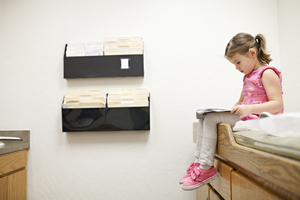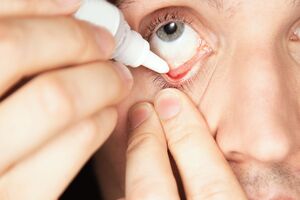Pediatric Dermatology
If you’ve been searching for a pediatric dermatologist to help your child with a skincare condition, it can be overwhelming. Solv helps simplify your search process with a convenient, hassle-free tool that connects you with top-rated local pediatric dermatologists so you can book online appointments instantly.
Here’s what you need to know about pediatric dermatologists, including how to find care near you.
What is a pediatric dermatologist?
According to the American Academy of Dermatology, a pediatric dermatologist is a skincare doctor who has specialized training in identifying, managing, and treating children’s skin, hair, and nail conditions. Children may develop conditions that do not occur in adults or look different from adults, so it’s vital to have an expert managing a skin, hair, or nail condition in a child, notes the Academy.
Similarly, some effective or safe treatments in adults may not be safe in children.
What does a pediatric dermatologist do?
According to the American Academy of Dermatology, the definition of a dermatologist is a “doctor who specializes in conditions involving the skin, hair, and nails.” All dermatologists are skilled at detecting and treating conditions in children; however, pediatric dermatologists have specialized training to manage more complex or rare conditions, particularly those not resolved with traditional management.
Education and training
A pediatric dermatologist can care for children across the spectrum, from infancy to adolescence. According to the Society for Pediatric Dermatology, a pediatric dermatologist must first complete a 3-year dermatology residency after medical school. Then, they must complete a 1- or 2-year fellowship at an accredited program and pass a certifying exam in pediatric dermatology. This will afford them the title of a board-certified pediatric dermatologist.
Reasons to see a pediatric dermatologist
Like a pediatrician, a pediatric dermatologist is especially adept at managing children and addressing their particular emotions and physical needs. A pediatric dermatologist’s office may be less intimidating to a child and may have child-size equipment. The dermatology team may also be more accustomed to treating children and speaking to them gently and reassuringly, which can be an excellent reason to seek care from a pediatric dermatologist rather than a general dermatologist, notes the Society for Pediatric Dermatology
A pediatric dermatologist may also be particularly helpful if your child has a skin condition that a pediatrician or a general dermatologist cannot fully manage, notes the Society for Pediatric Dermatology. Some pediatric dermatologists are especially skilled at managing certain conditions and their specific treatments, and this may be a reason to seek care from this type of specialist. If your child has a skin, hair, or nail condition that is especially rare or difficult to manage, a pediatric dermatologist is typically the type of medical provider who is best equipped to help.
Conditions treated
According to the Society for Pediatric Dermatology, a pediatric dermatologist can help with an array of skin, hair, and nail conditions that occur in childhood, including the following:
- Acne
- Acanthosis nigricans
- Allergic contact dermatitis
- Alopecia areata
- Atopic dermatitis (eczema)
- Hidradenitis suppurative
- Hemangiomas
- Herpes infections
- Hyperhidrosis
- Urticaria (hives)
- Juvenile xanthogranuloma
- Keratosis pilaris
- Lichen sclerosis
- Mastocytosis
- Moles
- Melanoma
- Molluscum contagiosum
- Nevus sebaceous
- Papular urticarial
- Perioral dermatitis
- Pediatric skin cancer
- Pigmentary mosaicism
- Pilomatricoma
- Psoriasis
- Port-wine stains
- Pyogenic granuloma
- Scabies
- Scars
- Spitz nevus
- Tinea infections
- Vitiligo
- Warts
- Seborrheic dermatitis
- Sometimes, a skin condition can be a hallmark of an underlying internal medical condition, so pediatric dermatologists must also be familiar with non-skin-related conditions in children, such as endocrine and neurologic conditions.
What to expect from the pediatric dermatologist
According to the Society for Pediatric Dermatology, at the pediatric dermatologist, you will usually first be asked about your child’s medical history, including allergies and any known medical conditions or current medications. Then, your child’s dermatologist will ask detailed questions about the history of the particular condition you are there to address. If you have been tracking the development of a skin condition (i.e., noting exposures that seem to worsen a rash or times of day when it flares up), it will be helpful to bring this information to the appointment. Then, the dermatologist will do a thorough physical exam, looking at the site of the concern and also checking other areas of the body, if applicable. If the dermatologist can make a diagnosis on the spot, they may suggest a management or treatment plan, taking into consideration your child’s age and temperament. Your child may also require testing, such as a biopsy or bloodwork, to reach a definitive diagnosis and treatment plan.
Find Pediatric Dermatology near you
- Alabama
- Alaska
- Arizona
- Arkansas
- California
- Colorado
- Connecticut
- Delaware
- Florida
- Georgia
- Hawaii
- Idaho
- Illinois
- Indiana
- Iowa
- Kansas
- Kentucky
- Louisiana
- Maine
- Maryland
- Massachusetts
- Michigan
- Minnesota
- Mississippi
- Missouri
- Montana
- Nebraska
- Nevada
- New Hampshire
- New Jersey
- New Mexico
- New York
- North Carolina
- North Dakota
- Ohio
- Oklahoma
- Oregon
- Pennsylvania
- Rhode Island
- South Carolina
- South Dakota
- Tennessee
- Texas
- Utah
- Vermont
- Virginia
- Washington
- Washington DC
- West Virginia
- Wisconsin
- Wyoming
Pediatric Dermatology FAQs
What is a pediatric dermatologist?
According to the Society for Pediatric Dermatology, a pediatric dermatologist is a doctor who specializes in treating skin, hair, and nail conditions that occur in children. Pediatric dermatologists have additional training that equips them to manage these conditions compared to general pediatricians or general dermatologists. However, general pediatricians and general dermatologists are also qualified to diagnose and manage skin conditions in children.
What ages does pediatric dermatologists treat?
Pediatric dermatologists treat children of all ages, ranging from birth to adolescence. Different skin conditions can manifest at different stages of childhood, and a pediatric dermatologist is specially trained to identify these as they occur and to recognize which treatments may be most appropriate for specific age groups, reports the Society for Pediatric Dermatology.
What kind of education or training do pediatric dermatologists have?
A pediatric dermatologist has received a 4-year undergraduate degree and attended a 4-year medical school. Then, they have completed a 3-year dermatology residency and a 1- or 2-year fellowship that gives them expertise in treating skin conditions in children, according to the Society for Pediatric Dermatology, . At the end of the day, they have at least eight years of training—and sometimes more—which makes them highly skilled at helping your child.
What types of treatments do pediatric dermatologists provide?
Pediatric dermatologists can typically provide several different forms of treatment. They can perform biopsies, excisions, or other treatments to remove skin lesions such as moles or warts. They can prescribe topical medications (applied to the skin), injected, or swallowed to help with skin conditions. They can also use other tools like UV light, lasers, or surgery to help manage skin conditions. Additionally, a pediatric dermatologist can recommend lifestyle measures (such as avoiding certain foods or cleansing the skin in a specific manner) to help limit the occurrence or reduce the frequency of a given skin condition.
Where can I find a pediatric dermatologist near me?
If you have been searching for a “pediatric dermatologists near me” or “Dermatologist near me,” it can be hard to sort through all of the information available on the internet. To simplify your search process, use the Solv care locator tool to connect instantly with the perfect fit.
Solv has strict sourcing guidelines and relies on peer-reviewed studies, academic research institutions, and medical associations. We avoid using tertiary references.
Everyday Healthcare, Simplified
Expert advice to help you live your best life








